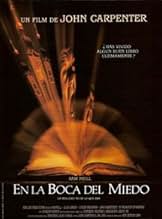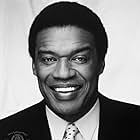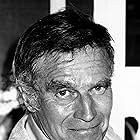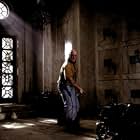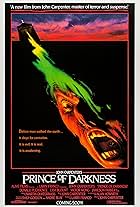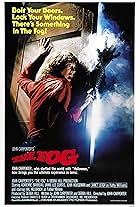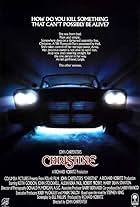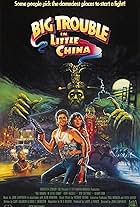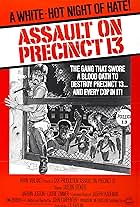An insurance investigator begins discovering that the impact a horror writer's books have on his fans is more than inspirational.An insurance investigator begins discovering that the impact a horror writer's books have on his fans is more than inspirational.An insurance investigator begins discovering that the impact a horror writer's books have on his fans is more than inspirational.
- Awards
- 1 win & 4 nominations
Jürgen Prochnow
- Sutter Cane
- (as Jurgen Prochnow)
- Director
- Writer
- All cast & crew
- Production, box office & more at IMDbPro
Storyline
Did you know
- TriviaIn the film, the works of Sutter Cane are occasionally quoted. Most if not all of these quotes are actually taken directly from several H.P. Lovecraft short stories with some adaptations to fit them into the film story. Most notably, in the scene where Styles reads to Trent as he gazes into the abyss--her speech lifts much of its description, including such elements as "the illimitable gulf of the unknown" from the last few paragraphs of Lovecraft's "The Rats in the Walls." In an earlier scene as well, Trent reads a line verbatim from Lovecraft's "The Haunter of the Dark," in reference to the black church being "the seat of an evil older than mankind and wider than the known universe."
- GoofsIt is highly unlikely that Trent could draw on his padded cell wall's with all the crosses with a single crayon and no ladder.
- Quotes
John Trent: This shit really sells doesn't it?
Linda Styles: More than you'd think. Surprised?
John Trent: Lady, nothing surprises me anymore. We fucked up the air, the water, we fucked up each other. Why don't we just finish the job by flushing our brains down the toilet?
- Crazy creditsAnimal action was monitored by the American Humane Association with on set supervision by the Toronto Humane Society. No animal was harmed in the making of this film.
Human interaction was monitored by the Inter Planetary Psychiatric Association. The body count was high, the casualties are heavy.
- Alternate versionsThe original theatrical release had the 1987-1994 New Line Cinema logo at the opening. The 2013 Blu-ray from Warner Bros. plasters it with the modern New Line logo. But the 2018 Blu-ray release from Shout! Factory restores the original logo.
- ConnectionsFeatured in Masters of Illusion: The Wizards of Special Effects (1994)
- SoundtracksWe've Only Just Begun
Written by Roger Nichols and Paul Williams
Performed by The Carpenters
Published by Irving Music Inc. (BMI)
Featured review
This movie is steadily growing on me. I've seen it twice now, and I more fully appreciate the descent into total insanity that it represents. Inspired heavily by H. P. Lovecraft with some nods to Stephen King, In the Mouth of Madness is John Carpenter creating a dream in a similar vein as Argento's Suspiria or Dreyer's Vampyr. These kinds of movies are about creating an alternate reality so complete and believable while being so removed from our actual experience that the unreality becomes ultimately believable in a subtle and subconscious way. This is also Carpenter, well-experienced in the technical side of filmmaking, bringing his A-game to the production.
Sutter Cane is the most successful horror author in the world, selling hundreds of millions of copies of his six books with his seventh, In the Mouth of Madness, due soon. The problem is that Cane has disappeared. In comes Sam Neill's John Trent, an insurance investigator, sent by the publishing house's insurance company to investigate the claim they made on the author's disappearance. Trent is a complete skeptic from the start, seeing right through people's bull from the start and unwilling to believe in much beyond man's ability to lie to each other. He doesn't think Cane disappeared inexplicably. He thinks that the head of the publishing firm (played by Charlton Heston) has created a publicity stunt to help them sell more books. He's willing to investigate if the publishing house is willing to accept the risk of him finding out that it's all a scam. He's sent, and with him the publisher sends Linda Styles (Julie Carmen), Cane's editor.
Now, the first act is interesting in how it tells all this. The first scene is Trent being dragged into an insane asylum, ranting and raving about the end of the world. He's interviewed and tells his story, beginning with a scene dealing with a fraud case, and the acting seems stiff and mannered here, reminding me of William Hurt's uncomfortable (I think intentionally so) performance as the detective in Dark City who's not really a detective. I think this was an intentional choice to make "reality" in In the Mouth of Madness feel off. When Trent is presented with the case by his occasional employer, they are attacked in a restaurant by a madman with an axe who asks Trent the simple question of, "Do you read Sutter Cane?" There's a sickness to the world, a world that doesn't quite seem right to begin with, from the start.
Things get more interesting when Trent buys the six books and begins reading them. Tales that Styles told him of people encountering mental issues after reading them sit in the back of his mind as he begins to have increasingly disturbing variations of the same dream of a cop beating a man in an alleyway with the cop transforming from a man to some kind of deteriorating monster.
Trent and Styles take a car to New Hampshire, following clues found on the covers of Cane's books, to look for a town on no map, and the trip is this weirdly ethereal journey out of reality and into the world of Hobb's End. Repeated images of a boy riding a bicycle, later shown as an old man still riding, greet them. Trent falls asleep, Styles drives as the lines on the road disappear in the middle of the night, and she's suddenly over a covered bridge and into Hobb's End, the town of Cane's novels, a place that shouldn't be real.
The time in Hobb's End is a bit of a meandering bit of business in terms of strict storytelling, but it never lets up this increasing sense of unease. We kind of reset once the two characters enter Hobb's End. Night instantly turns to day, and everything looks happy and cheerful, but no one's around. There's definitely something wrong. They go to the hotel and check in, finally meeting the old woman who runs the place who also ends up being a character from Cane's books. In the books, she tortures and murders her husband, but she seems like such a nice little old lady that we, and Trent, have a hard time believe that she could do much of anything. But there's definitely something going on, and it becomes obvious when they travel to the church at the center of town and see Cane. He holds a child hostage against the force of townspeople who rush the place and try to free the boy, but can any of this be real?
Through it all, Trent maintains his insistence that everything he sees is some kind of publicity stunt designed to get him to run to the newspaper to spread the story of Sutter Cane's secret town and the evils that lay beneath it, but as things gets weirder, his efforts to explain it all away become increasingly inward justifications for his own beliefs. His reality is breaking down around him.
The final third of the film is Trent escaping from Hobb's End and trying to make sense of the deteriorating world around him. Cane gives him the manuscript for In the Mouth of Madness that he must give to the publisher so that belief in Cane's world will increase and open up the portal for the Old Ones, hideous beyond description monsters from another dimension that we only see in the edges of frame, chasing Trent out of Hobb's End and back into the real world. What follows is the complete destruction of society, supposedly wrought by the insanity hiding in the book. Trent goes further down the track as well, eventually turning into an axe murderer himself, the event that leads him to the insane asylum at the beginning of the film.
The terror at the heart of In the Mouth of Madness is the idea that everything we see is wrong, and that the reality we deny ourselves is more horrible than we can even imagine. It's the sort of terror that H. P. Lovecraft was well known for, and it only ever seemed to work in print. The terror of the unknown, resolving to solid writing around the indescribable is one thing, actually having to use image is something else. Carpenter, as well as the film's writer Michael de Luca (also executive producer and head of New Line Cinema at the time), find ways to make this sort of horror real in the visual space as well. It's the application of the inexplicable, like the image of Sutter Cane whom we have known as a real person, suddenly tearing at his face like a page of a book revealing terror beneath it. It so betrays the laws of reality as we know it, but the world created around it has been so convincing and removed from our own experience at the same time that it becomes both believable and awful.
Anchoring all of this is Neill as Trent, and he's fantastic. The steady degradation of his mental state is precisely played out by Neill, going from collected to completely embracing his own insanity. Jürgen Prochnow is Sutter Cane in complete control of his own madness. Julie Carmen as Styles is a bit of a weak link in a part that doesn't seem to go as far as it should, but it's great to see Charlton Heston in the small role as the publisher, creating pure gravitas with every line.
There's so much to admire in In the Mouth of Madness, but it's also easy to see why it might have rubbed people the wrong way upon its original release. It does have a traditional three act structure, but that familiarity is undermined by the absolute ruthlessness that Carpenter takes Trent into complete insanity. There's something really special at the heart of this film, and it just keeps growing on me with every viewing.
Sutter Cane is the most successful horror author in the world, selling hundreds of millions of copies of his six books with his seventh, In the Mouth of Madness, due soon. The problem is that Cane has disappeared. In comes Sam Neill's John Trent, an insurance investigator, sent by the publishing house's insurance company to investigate the claim they made on the author's disappearance. Trent is a complete skeptic from the start, seeing right through people's bull from the start and unwilling to believe in much beyond man's ability to lie to each other. He doesn't think Cane disappeared inexplicably. He thinks that the head of the publishing firm (played by Charlton Heston) has created a publicity stunt to help them sell more books. He's willing to investigate if the publishing house is willing to accept the risk of him finding out that it's all a scam. He's sent, and with him the publisher sends Linda Styles (Julie Carmen), Cane's editor.
Now, the first act is interesting in how it tells all this. The first scene is Trent being dragged into an insane asylum, ranting and raving about the end of the world. He's interviewed and tells his story, beginning with a scene dealing with a fraud case, and the acting seems stiff and mannered here, reminding me of William Hurt's uncomfortable (I think intentionally so) performance as the detective in Dark City who's not really a detective. I think this was an intentional choice to make "reality" in In the Mouth of Madness feel off. When Trent is presented with the case by his occasional employer, they are attacked in a restaurant by a madman with an axe who asks Trent the simple question of, "Do you read Sutter Cane?" There's a sickness to the world, a world that doesn't quite seem right to begin with, from the start.
Things get more interesting when Trent buys the six books and begins reading them. Tales that Styles told him of people encountering mental issues after reading them sit in the back of his mind as he begins to have increasingly disturbing variations of the same dream of a cop beating a man in an alleyway with the cop transforming from a man to some kind of deteriorating monster.
Trent and Styles take a car to New Hampshire, following clues found on the covers of Cane's books, to look for a town on no map, and the trip is this weirdly ethereal journey out of reality and into the world of Hobb's End. Repeated images of a boy riding a bicycle, later shown as an old man still riding, greet them. Trent falls asleep, Styles drives as the lines on the road disappear in the middle of the night, and she's suddenly over a covered bridge and into Hobb's End, the town of Cane's novels, a place that shouldn't be real.
The time in Hobb's End is a bit of a meandering bit of business in terms of strict storytelling, but it never lets up this increasing sense of unease. We kind of reset once the two characters enter Hobb's End. Night instantly turns to day, and everything looks happy and cheerful, but no one's around. There's definitely something wrong. They go to the hotel and check in, finally meeting the old woman who runs the place who also ends up being a character from Cane's books. In the books, she tortures and murders her husband, but she seems like such a nice little old lady that we, and Trent, have a hard time believe that she could do much of anything. But there's definitely something going on, and it becomes obvious when they travel to the church at the center of town and see Cane. He holds a child hostage against the force of townspeople who rush the place and try to free the boy, but can any of this be real?
Through it all, Trent maintains his insistence that everything he sees is some kind of publicity stunt designed to get him to run to the newspaper to spread the story of Sutter Cane's secret town and the evils that lay beneath it, but as things gets weirder, his efforts to explain it all away become increasingly inward justifications for his own beliefs. His reality is breaking down around him.
The final third of the film is Trent escaping from Hobb's End and trying to make sense of the deteriorating world around him. Cane gives him the manuscript for In the Mouth of Madness that he must give to the publisher so that belief in Cane's world will increase and open up the portal for the Old Ones, hideous beyond description monsters from another dimension that we only see in the edges of frame, chasing Trent out of Hobb's End and back into the real world. What follows is the complete destruction of society, supposedly wrought by the insanity hiding in the book. Trent goes further down the track as well, eventually turning into an axe murderer himself, the event that leads him to the insane asylum at the beginning of the film.
The terror at the heart of In the Mouth of Madness is the idea that everything we see is wrong, and that the reality we deny ourselves is more horrible than we can even imagine. It's the sort of terror that H. P. Lovecraft was well known for, and it only ever seemed to work in print. The terror of the unknown, resolving to solid writing around the indescribable is one thing, actually having to use image is something else. Carpenter, as well as the film's writer Michael de Luca (also executive producer and head of New Line Cinema at the time), find ways to make this sort of horror real in the visual space as well. It's the application of the inexplicable, like the image of Sutter Cane whom we have known as a real person, suddenly tearing at his face like a page of a book revealing terror beneath it. It so betrays the laws of reality as we know it, but the world created around it has been so convincing and removed from our own experience at the same time that it becomes both believable and awful.
Anchoring all of this is Neill as Trent, and he's fantastic. The steady degradation of his mental state is precisely played out by Neill, going from collected to completely embracing his own insanity. Jürgen Prochnow is Sutter Cane in complete control of his own madness. Julie Carmen as Styles is a bit of a weak link in a part that doesn't seem to go as far as it should, but it's great to see Charlton Heston in the small role as the publisher, creating pure gravitas with every line.
There's so much to admire in In the Mouth of Madness, but it's also easy to see why it might have rubbed people the wrong way upon its original release. It does have a traditional three act structure, but that familiarity is undermined by the absolute ruthlessness that Carpenter takes Trent into complete insanity. There's something really special at the heart of this film, and it just keeps growing on me with every viewing.
- davidmvining
- Sep 20, 2021
- Permalink
Details
- Release date
- Countries of origin
- Language
- Also known as
- En la boca del terror
- Filming locations
- Cathedral of the Transfiguration, Markham, Ontario, Canada(the black church - exterior)
- Production companies
- See more company credits at IMDbPro
Box office
- Budget
- $8,000,000 (estimated)
- Gross US & Canada
- $8,924,549
- Opening weekend US & Canada
- $3,441,807
- Feb 5, 1995
- Gross worldwide
- $8,926,413
Contribute to this page
Suggest an edit or add missing content









